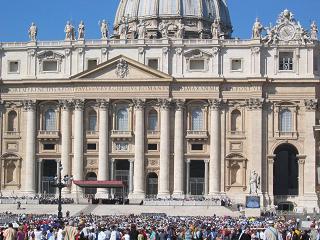|
|
 |
|
St. Peter's Piazza |
|
written
by minhan / 09.22.2005 |
|
|
| |
Function |
| |
| |

|
| www.answers.com |
| Ponte dell'Angelo |
| The Bridge of Angels with a glimpse of St. Peter's Basillica. |
| |
|
| |

|
| Photo by Minh-An Nguyen |
| Papal Audience |
| Here is a picture of a papal audience that the class all got to see on Wednesday September 14, 2005. |
| |
|
Bernini designed the piazza using the Tuscan form of Doric because of the strength needed but also the emotion that was evoked from this style. Although the roots of the architectural designs chosen by Bernini, the trapezoid and the oval shapes, were already in the Renaissance urban schemes, his use of the idea, “shapes, sequences, and components” created a new era – his own era. The traditional Baroque style together with Bernini’s unique creativity allowed Bernini to create many optical illusions and various perspectives evoking various emotions depending on the approach to the piazza by using the colonnades and both the trapezoidal and elliptical shape of the piazza.
The approach of the piazza was carefully designed by Bernini. The pilgrim would enter the piazza after going on the Ponte dell’Angelo across the Tiber River, passing the Castel Sant’Angelo and then going through the narrow streets connecting to the ends of the colonnade. The Ponte dell’Angelo is lined with ten angels, each holding a relic form the Passion of Christ. This passage was to ready the pilgrims to a spiritual state after getting a glimpse of the great St. Peter’s Basilica before dwelling back into the narrow streets. Since many pilgrims came from all across the world and had traveled long distances, first seeing the basilica gave many pilgrims that extra energy to keep going. When the pilgrim reached the end of the narrow streets, the piazza with its open lighten space would feel heavenly. The approach allowed for a revelation experience for the pilgrim.
The Piazza Obliqua, the transverse oval component, allowed the pope to offer blessings clearly to the visitors in the piazza from more than one place. The pope would give Christmas and Easter blessings from the Benediction Loggia, which is in the middle of the façade, and could also give blessings from the window of his high private apartment in the Vatican Palace.
The Piazza Retta, with its wider side of the trapezoid towards the St. Peter’s façade, creates “a heightened perspective for a visitor leaving the basilica.” The low unparallel corridors that become further apart the nearer they are to the façade make the basilica seem shorter than it really is. The visual illusion from the shape of the Piazza Oblique and Retta causes the distance between the basilica and the far rim of the piazza seem shorter. Overall, this creates an optical illusion of St. Peter’s being closer to the viewer, and in turn the façade looks shorter and more proportional to its width.
Along with the emotional, spiritual feeling denoted by the shape of the piazza, Bernini also thought about the visual effects. He used the High Renaissance theme of “depth and illusion, solid and void, and light and dark.” Usually when looking at the sunlit columns, the viewer sees them as gradually row-by-row fading into the darkness. Furthermore, these rows of columns has a visual impact called stereoscopic, which means that closer columns pass the viewer’s eye faster than the rows farther away. The open columns with no solid background create an open airy area. Together, these effects create a sense of constant movement and create a sense of ease, which would not occur if it was a solid rigid circle.
The redesigning and building of the piazza represented a “monumental revival of the city’s ancient glories.” It provided a nurturing and sacred environment for the faithful, which at that particular period the Catholic Church “strongly depended for as its appeal.” The piazza transformed the Vatican City by creating a path that commemorated the triumph of Christ. Even rival architects, such as Stendhal, agreed on the beauty of the piazza. Stendhal commented on how the narrow streets of the Borgo accentuated the impact of the piazza; “the great open space was a revelation … which literally took the breath away.” Overall, the piazza provided a source of inspiration for both worshipers and visitors.
|
| |
|
| |
|
|
 |
|

